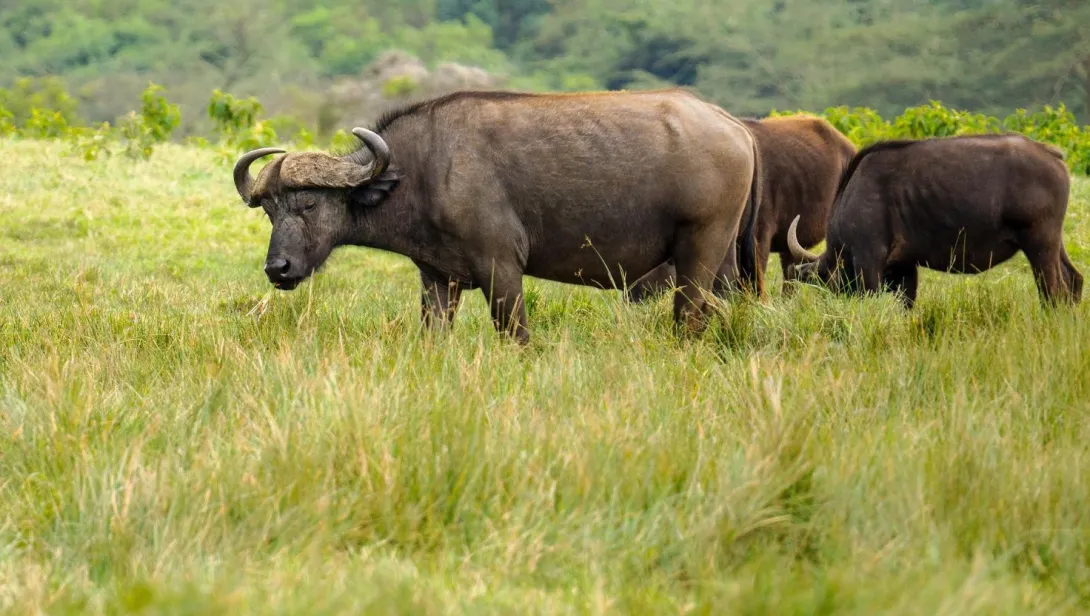Skip to main content
General Information
- The Water Buffalo (Bubalus bubalis) is a large domesticated bovine found in Asia, Africa, and parts of Europe.
- It is one of the most important livestock animals, providing milk, meat, and labor to millions of people.
- There are two main types: the Swamp Buffalo and the River Buffalo, each adapted to different environments.
- Wild populations, known as Wild Water Buffalo (Bubalus arnee), are endangered and primarily found in South Asia.
- Water buffaloes are often mistaken for domestic cattle, but they have larger horns and thrive in wet environments.
Physical Characteristics
- Water buffaloes have a large, muscular body covered with dark gray or black skin.
- Adult males, called bulls, can weigh between 700 to 1,200 kg (1,500 to 2,600 lbs).
- Females, known as cows, are smaller, weighing around 500 to 800 kg (1,100 to 1,750 lbs).
- They have long, curved horns that can reach up to 2 meters (6.5 feet) in length.
- Unlike domestic cattle, their skin has fewer sweat glands, making them rely on water and mud to stay cool.
Habitat and Adaptation
- Water buffaloes prefer swamps, marshes, and riverbanks where they can submerge in water.
- They are highly adapted to hot and humid climates, commonly found in India, China, Southeast Asia, and Africa.
- They spend hours wallowing in mud to protect themselves from the heat and parasites.
- Wild water buffaloes inhabit grasslands and tropical forests but are now rare due to habitat destruction.
- Domesticated water buffaloes are widely used in agriculture, especially in rice farming.
Diet and Feeding Behavior
- Water buffaloes are herbivores, primarily feeding on grasses, aquatic plants, and crops.
- They can digest tough plant material thanks to their four-chambered stomach.
- They require a large amount of water daily and are often seen grazing near water sources.
- Farmers use them to clear overgrown vegetation, helping to manage ecosystems.
Social Behavior
- Water buffaloes are social animals that live in herds led by dominant females.
- Males form separate bachelor groups but join female herds during mating season.
- They communicate through grunts, body movements, and chemical signals.
- Domesticated buffaloes form strong bonds with humans and are used for plowing fields and transportation.
Reproduction and Lifespan
- Water buffaloes have a breeding season that varies by region.
- The gestation period lasts about 10-11 months, after which a single calf is born.
- Calves are nursed for several months before they start grazing.
- They reach sexual maturity at around 3 years of age.
- The average lifespan of a domesticated water buffalo is 20-25 years, while wild buffaloes may live up to 15 years.
Threats and Conservation
- Wild water buffaloes are classified as endangered due to habitat loss and hunting.
- Crossbreeding with domestic buffaloes threatens the genetic purity of wild populations.
- Domesticated water buffaloes are vital for rural communities, but disease outbreaks can impact their populations.
- Conservation programs aim to protect wild buffaloes and prevent further decline.
Economic and Cultural Importance
- Water buffaloes are widely used in agriculture for plowing, transportation, and irrigation.
- They produce high-fat buffalo milk, which is used to make cheese, butter, and yogurt.
- Buffalo meat, known as carabeef, is an important food source in many countries.
- They are an integral part of festivals and religious traditions in parts of Asia.
Interesting Facts
- The largest population of domesticated water buffaloes is found in India.
- They are excellent swimmers and can cross rivers with ease.
- The Italian mozzarella cheese is traditionally made from buffalo milk.
- Water buffaloes play a role in reducing wildfires by eating dry vegetation.
- Despite their size, they are gentle and intelligent, often forming strong bonds with farmers.
